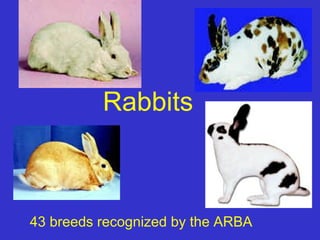
43 Rabbit Breeds Recognized by ARBA
- 1. Rabbits 43 breeds recognized by the ARBA
- 2. Milo : available for adoption
- 3. New Zealand White White, pink eyes, used most often for meat production in the U.S. Developed in U.S. (12 lbs.)
- 4. Florida White ½ the size of New Zealand Whites (6 lbs.). Developed for research. Florida White was developed from a cross between an albino American Dutch, a white Polish and a small New Zealand White.
- 5. Himalayan Widely distributed around the world. From Himalayan Mountain Regions .
- 6. Giant Chinchilla (16 lbs.)
- 7. Californian Developed in the 1920’s. Second most popular meat breed in the world. (10.5 lbs.) ½ New Zealand, ¼ Himalayan, ¼ Chinchilla
- 8. Varieties include sandy, fawn, white, light gray, steel gray, black, blue Flemish Giant – one of the largest breeds and is used as a terminal cross. U.S. Club started in 1915. Minimum weight for does is 14 lbs.
- 9. Rex rabbits - fine silky textured coat (Max weight 10.5 lbs.) 16 varieties.
- 10. Dutch – varieties include black, gray, tortoise, blue, chocolate, and steel. Ideal weight is 4.5 pounds – max is 5.5 lbs.
- 11. Mini-lop – max size is 6.5 lbs. Mini-Lop Club of America originated from German imports in 1974
- 12. French Lops
- 13. English Lop
- 14. Belgian Hare – max weight 9.5 lbs.
- 15. Lionhead rabbit
- 16. Angora
- 21. Manure removal
- 24. Twenty-two lb. Herman belongs to a breed called the German Giant, reports the newspaper The Daily Mail. A spokesperson from the German Rabbit Breeders' Association said: "They are good- natured, reliable and calm. They are, however, because of their size, not very suitable for children."
- 25. Darius is 4 feet, 3 inches from his wiggly nose to his puffy tail, and weighs in at 50 pounds. And while he’s not quite the size of Wallis and Gromit’s were-rabbit, he’s still young — and still growing. Guinness World Records has certified Darius’ record based on length (2010).
- 26. B. Genera – 11 different ones # of pairs chromosomes 1. Lepus (hares) : Jack Rabbits 24 2. Sylvilagus: Cottontails 21 3. Oryctolagus: Wild European 22 rabbits and domestic descendants If a buck breeds a doe of a different genera the eggs are fertilized but the embryos die early in gestation.
- 27. Jack Rabbits are fully haired, eyes open, and can run within a few minutes of birth.
- 30. European wild hares engage in a courtship ritual involving dashing about wildly and leaping into the air. Hence the term – March Madness or “mad as a hare in March”.
- 31. II. Domestication A. Iberian Peninsula – Spain and Portugal B. Early Roman times kept in walled rabbit gardens C. Released on islands in sea lanes to be used as a food source D. 1859; a pair was released in Victoria, Australia. In 30 years multiplied to 20 million rabbits E. True domestication began in the 1500’s at French monasteries.
- 32. www.fao.org Country # rabbits China 515 million Venezuela 130 million Italy 170 million Korea 103 million Spain 59 million In 1996 rabbits numbered 817 million. World 1,196 million
- 33. IV. Rabbit Production in the U.S. Arkansas and surrounding states, Pennslyvania and Pacific states have a rabbit meat industry. 2% of households have 5 million pet rabbits. 1,500 sanctioned rabbit shows 600,000 rabbits used in research each year. Rabbits also raised for fiber.
- 34. V. Rabbit Management A. one buck for 10 to 70 does B. does can be bred at 4.5 to 5.5 months C. mating process: Rabbits are induced ovulators. A doe’s reproductive cycle is 16 – 18 days – not receptive to male on 4 days of cycle. Less receptive in late fall and winter. a. Doe is taken to buck’s cage. b. Buck mounts doe. c. Doe raises rear slightly. d. Buck ejaculates and falls on side.
- 35. D. Gestation period: 31 days, palpation for pregnancy at 10-14 days E. nest box added to cage at day 28-29 F. Kindling at day 31 – remove stillborn or deformed kits. Can foster kits. G. European litter management: a. kits have access to doe 5 minutes per day. b. doe bred on day 11. c. bunnies have free access to doe day 14. d. wean on day 30.
- 36. H. Identification systems: a. Tattoo numbers in ears b. Ear tags – chicken wing bands c. Temporary ID – write with felt tip pen in ear.
- 37. Advantages and Disadvantages of Rabbits for Meat Production.
- 38. Advantages: 1.Relatively cheap to get started on small scale. 2.Can raise in urban back yard without a permit. 3.Easy to handle. 4.Multiply rapidly. 5.Short generation interval. 6.Lean, white meat. 7.Excellent feed efficiency.
- 39. Disadvantages: 1.Few established markets. 2.Too cute to eat for some people. 3.Butchering more difficult than chicken. 4.Must be slaughtered young for best quality. 5.Because it is very lean, very easy to over cook. 6.Waste can generate strong ammonia smell.
- 40. VII. Sample yearly cash flow for a 50-doe rabbitry Expense: Income: housing $267 fryers 1750 @ $2.90 = $5075 equipment 240 stewers 50 @ $2.00= 100 breeding stock 100 feed 2760 utilities 120 insurance 60 misc. 60 $3607 $5175 Net of $1568 for the 50 does. 10 hours of labor are required per doe per year.
- 41. Rare bunny, born without ears, stepped on, killed at his own press conference – 3/15/2012, Germany.
- 59. The End!
Hinweis der Redaktion
- Himalayan are long and narrow. Note how level they are from the shoulders to the rump compared to other rabbits. They have a calm disposition and make good pets.
- Rabbit numbers have been increasing